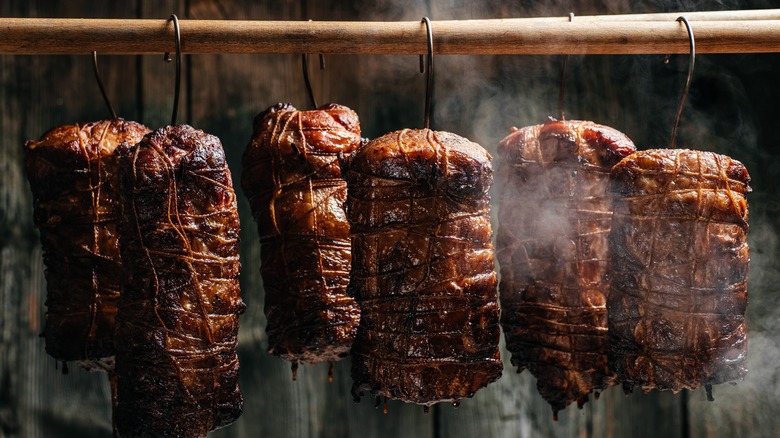Is Ham Considered Red Meat Or Not?
From dressed-up holiday centerpieces to jambon-beurre sandwiches, ham is a staple on tables around the world. Multiple surveys put ham just below turkey when it comes to popularity, and on Thanksgiving day, Americans eat around 619 truckloads of bone-in ham, according to industry consultant Len Steiner (via Washington Post). Given how often ham is eaten, you might be curious about its nutritional value, as well as its classification. So is ham red meat or not?
Back in the '80s, pork was famously dubbed "The Other White Meat," and the advertising slogan largely stuck. However, while many were swayed by the campaign, others continued to classify pork as red meat. Things get more confusing when considering pork's reddish-pink cousin, ham. Is it red meat, or does it belong in its own category? We went looking, and the World Health Organization (WHO) had the clearest answer.
How meat is classified (and where ham fits in)
To understand where ham falls on the meat spectrum, let's start with the basics. Ham is derived from the hog's hind leg. Being mammals, the pork from pigs is, yes, classified as red meat by the WHO. This is because pork contains a fair bit of the protein myoglobin, which imparts a red color to meat when it's exposed to air. Pork contains less myoglobin than beef and lamb cuts, but has much more than white meats like chicken or turkey.
Meat classification isn't just about the animal it comes from; the processing it undergoes also matters. Processes like curing, smoking, or salting lead to the categorization of meats like ham, crispy bacon, hot dogs, sausages, prosciutto, and salami as processed meats. Ham, for instance, is typically cured with salt, nitrites, or other preservatives. This process decreases the moisture of the meat, making it less hospitable to bacteria that can spoil it. Nitrite also contributes to the characteristic pink color of ham. Some ham is also smoked for added flavor and color. While these processing techniques make ham tasty and extend its shelf life, the WHO's classification of ham as processed meat also signifies potential health implications.
Why ham's classification matters for your health
In a 2015 report by the WHO, in partnership with the International Agency for Research on Cancer (IARC), red meat was identified as a probable carcinogen, while processed meat was classified as a definite carcinogen. This conclusion was drawn after researchers examined 800 studies on cancer in humans, finding a link between red meat and certain cancers and an even stronger link when it came to processed meats. According to a later report put out by the agency, chemicals formed during meat processing are the likely culprit for processed meat's cancer-causing ability. While this might sound alarming, it doesn't mean you need to banish ham from your diet.
In a WHO Q&A, the organization clarified that the cancer risk associated with processed foods isn't on par with known carcinogens like tobacco and asbestos, and the relatively marginal health risk it poses escalates with increased consumption. For example, if you consume 50 grams of deli-style ham (or about four slices) every day, your risk of colorectal cancer will increase by 18%. Eating ham less frequently than this, or in smaller amounts can reduce this risk. Plus, ham still has some nutritional benefits; it's rich in protein and a significant source of selenium, providing as much as 76% of the Daily Value of this mineral. So although it is both red meat and processed meat, ham can still have a place in a well balanced diet.


